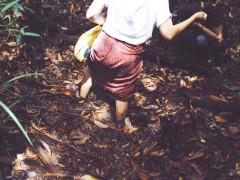Peatland Ancestors
By Admin Pantau GambutWaiting for the New Leader's Action in Overcoming Land and Forest Fires in Jambi

The forests and peat in Jambi are getting becoming increasingly vulnerable and regularly caught fire. Deforestation and massive exploitation through the use of concession permits make the peat ecosystems fragile and under pressure. However, the fact is that forests and peatlands not only act as carbon sinks but also serve as the foundation to sustain food security.
The worst forest and land fires in Jambi occurred in 2016. The state suffered trillion rupiah of losses due to the weakened economy and environmental damage. In addition, more than 100,000 people also suffered from URTI.
However, this bad experience keeps repeating. After 2015, fires occurred almost every year. The year 2019 seems to be a repeat of the disaster that occurred four years prior. Forest and land fires are a frightening specter that continues to terrorize in every dry season.
How long will this persist?
There is a new leader in Jambi Province. Forest and land fires are a generational issue that has not been resolved.
The Jambi government has always prioritized infrastructure development and economic improvement. Although everyone knows that forest and land fires can trigger serious adverse effects on the economy and health, and even threaten people's lives.
We all still remember how the haze in the 2019 fires resulted in the death of four Jambi residents. They lost their lives whilst trying to extinguish the fires, and some died because they couldn't handle the poor air quality.
In August 2019, Asmara, a member of Manggala Agni Daops Muara Bulian, Batanghari District, died when a tree fell on him whilst he was looking for a water source to extinguish the fire in Senami Village, located in KM 13 of the Tahura. Not even a month later, Suparmi, a resident of Rt.08 Matagual Village, Batin XXIV Sub-District, Batanghari District also experienced the same thing. A tree fell on the 40-year-old woman while she was trying to extinguish a fire in her rubber plantation.
Ahmad Tang, a 55-year-old male resident of Sei. Jambat Village, Sadu District, who has acute asthma also died due to the poor air quality caused by the forest and land fires. In fact, four days earlier, a resident of the Anak Dalam Pangkalan Ranjau Tribe, South Bahar Sub-District, Muaro Jambi District, also died of an asthma relapse because he couldn't stand the haze.
The sky in Kumpeh Sub-District, Muaro Jambi District turned red in September 2019. The fire was out of control and burned thousands of hectares of peatland. Jambi was shrouded in thick haze for months. The air quality in Jambi City was at a dangerous level for days.
The peak occurred on 16 October 2019, at 08.00 WIB where the data from the Jambi City Environmental Office Air Quality Monitoring System (AQMS) showed that the PM concentration reached a dangerous level (1,618). The air in Muaro Jambi, which has the largest peat area in Jambi, is equally dangerous.
The Jambi Provincial Health Office noted that more than 63,000 Jambi residents were reported to have been infected with URTI due to the haze. Jambi City has the highest number of URTI cases. There were more than 24,000 URTI cases, 60 percent of them occurring in children, between August – 2nd week of October 2019. Dozens of pregnant women also suffered from the haze.
The poor air quality also forced the Jambi City Government to dismiss all school activities. This step was also carried out by almost all the districts in Jambi that were affected by the haze.
KKI Warsi’s calculations indicated that the 2019 fires have cost the state up to Rp 12 trillion, which is significantly higher than the Jambi Province's local revenue. That number could be much higher if the economic losses, health costs, and effects from the children who cannot go to school are taken into account.
A difficult task awaits the new Jambi Governor. Land and forest fires is an important and urgent issue that needs to be resolved immediately to prevent them from continually recurring. The people of Jambi have suffered enough from the annually recurring haze-related disasters.
The fire extinguishing efforts that have been carried out so far have proven to be ineffective and tend to be costly. The government should focus on massive prevention efforts and should not just focus on management efforts.
The Jambi government is still hesitant in taking firm action against permit holders that have been proven to be negligent and have failed to carry out their responsibilities. Without realizing it, this weak attitude has prolonged the recurring forest and land issues.
The government should not be afraid or worried about the economic impact. The government must act firmly against companies that have been proven to be negligent. Even to the extent of revoking their permit if required. The government needs to have this firm attitude to avoid state losses stemming from the forest and land fires and to save the community from disasters.
It is a known fact that plantation companies and industrial forest plantations (HTI) have control over more than half of the Jambi peat area. Referring to data published by the Indonesian Forum for the Environment (Walhi) - Jambi, approximately 70 percent out of the total 751,000 hectares of peatland in Jambi have been issued concession permits for oil palm plantations and HTI.
However, these companies have actually destroyed 122 peat endemic plant species. The construction of the company's dam also has a negative impact on the surrounding community’s agricultural land, which is often inundated by prolonged flooding. On the other hand, the canals built to drain the peat makes the peat vulnerable and prone to fire.
KKI Warsi noted that more than 154,000 hectares of land were burned in 2019. More than half of them were peatlands. Twenty company concession areas have experienced recurring fires, most of which are on peatland concession areas.
Data from the Jambi Province Regional Disaster Management Agency (BPBD) shows that a total of 258 villages are areas prone to forest and land fires area in 2020. More than 100 villages are located in the peat areas distributed in the West Tanjung Jabung, East Tanjung Jabung, and Muaro Jambi Districts. In general, these villages are located in the vicinity of a company concession area. This indicates that there is a serious problem that requires immediate resolution.
The new Jambi leader has a tough duty of saving Jambi from the forest fire and haze disaster. The government should also start thinking about improving the community's economy through policies that favor environmental sustainability, without having to entirely rely on the investors. (*)
*The author is the Director of Green Association and Coordinator of Simpul Jaringan Pantau Gambut Jambi
**THIS ARTICLE WAS PREVIOUSLY PUBLISHED IN THE JAMBI ONE KOLOS PRINTED MEDIA (PAGE 5) ON 18 DECEMBER 2020 AND AKSES JAMBI, JERNIH.ID, JAMBI INDEPENDENT, KENALI, JAMBI ONE, JAMBI UPDATE, JAMBERITA AND DETAIL.ID ONLINE NEWS PORTAL**



